
Last weekend, Crowfall developer ArtCraft Entertainment held the last of its February playtest weekends, inviting the game’s Early Access backers to jump into the gameworld to play, test, and provide feedback on the game in its current state of development. As one of said Early Access backers (full disclosure there), I was among those invited to take part in the test, and having last played the game sometime early last year, I figured now would be a good time to pop in and see how the game’s coming along.
At present, the game build is a very early one that the devs have dubbed Pre-Alpha 2.0, so the features on display during the playtests are both limited and almost certain to undergo radical changes between now and Crowfall’s eventual launch. The game’s current, rather bare-bones incarnation includes the frameworks, in varying stages of completion and polish, for its basic gathering, crafting, and PvP combat features, though my playtime over the weekend was limited largely to the former two, with relatively little in the way of bloodshed. I don’t consider that to be altogether a bad thing, though; even this early implementation of Crowfall’s gathering and crafting systems is intricate enough that I reckon it deserves a column in and of itself, so let’s go ahead and dig in.
When you first log into the game and choose your first vessel (I chose the adorable, straight-outta-Redwall duelist, if you were wondering), you’re effectively, but thankfully not literally, naked as the day you were born, devoid of any equipment whatsoever. So the first order of business is to get yourself outfitted with some starting gear, and the only way of doing that—short of finding yourself a generous benefactor to donate some freebies—is to craft it yourself. And before you craft anything, you’ve got to gather up some raw resources for materials.
The general gathering-crafting cycle will be fairly familiar to anyone who’s ever played a crafting-survival game like Minecraft or its many offshoots: You harvest materials with which to make better gear, which in turn lets you harvest higher-tier materials with which to make even better gear, etc. In Crowfall, there are four main types of raw materials, each with an associated harvesting tool: wood, harvested with axes; stone, harvested with hammers; metal ore, harvested with picks; and skins, harvested with knives.
As a fresh vessel, you start with nothing but a basic axe. There’s a special beginner recipe to craft your basic array of starter harvesting tools, and the specific tool it creates is dependent on the material used to craft it. Using wood creates a hammer, allowing you to harvest stone, which in turn creates a pick that lets you harvest metal ore, which finally creates a knife that lets you skin dead creatures. Similarly, there are special beginner recipes to craft a basic set of weapons and armor. They’re spectacularly cheap, requiring only a handful of resources to create, but they don’t allow much in the way of customization, and their stats are underwhelming to say the least.
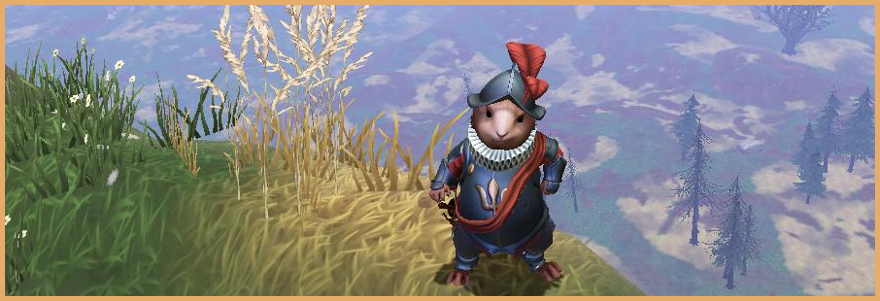
The overall crafting process, like resource-gathering, should be familiar to anyone who’s ever played a crafting-survival game or just about any MMO with crafting in it. In a nutshell, you choose a recipe, gather up the necessary resources, stick ‘em in the appropriate slots, and craft the item. Or try to, anyway. If a character’s skill level in the relevant crafting discipline isn’t high enough, there’s a chance for the craft to fail, consuming all materials in the process.
This will probably be the most contentious aspect of the game’s crafting system, and I can personally attest to its rage-inducing potential. Don’t get me wrong: I think a solid system of risk-vs.-reward is essential, especially in a high-stakes PvP title like Crowfall, but failing to craft an item with a 97% chance of success is uniquely infuriating, especially considering the immense time and resource investments involved, as we will see shortly.
Before I can go into detail about the crafting process, though, I first need to explain a bit how the materials function. Materials are classified based on two attributes: grade and rarity. Grade is a numerical value from one to whatever the highest grade is—I have no clue, though the highest I saw was grade five—that serves as an indicator of a material type’s overall quality. All materials of a given type share the same grade; i.e., slag is considered a grade one metal, while gold is grade 5. Higher-grade resources seem generally less common than lower-grade ones and tend to require higher-quality tools to harvest effectively, but they result in much higher-quality items when used as crafting materials.
A material’s rarity, indicated with the grey-white-green-blue-etc. spectrum that should be familiar to most anyone who’s played an MMO in the past decade or so, can be looked at as an indicator of an individual piece of material’s quality in relation to other pieces of the same material. Take again the previous example of slag versus gold: Gold, being of a much higher grade than slag, will always (to my knowledge) be of better quality, but when mining a gold vein, each individual piece of gold you receive may be common, uncommon, rare, etc.
Now, on to why that whole infodump is important: Crowfall’s crafting system is intricately modular, to put it mildly. You’ll see what I mean in a minute. Given the complexity of the systems at work here, I think it’ll be easier to explain by way of demonstration, so let’s look at the process of crafting a shiny new gun.
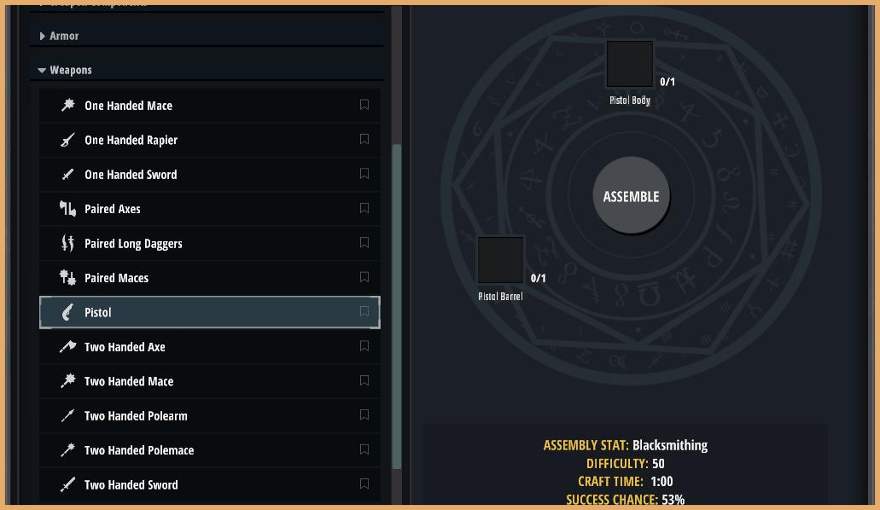
The screenshot above shows the recipe to create a pistol. As you can see, it requires only two materials: a pistol body and a pistol barrel. “What’s so intricately modular about that?” you might ask. Well, as you may have surmised, both of those components are themselves crafted items, so let’s go ahead and look at the recipes for the body and barrel.
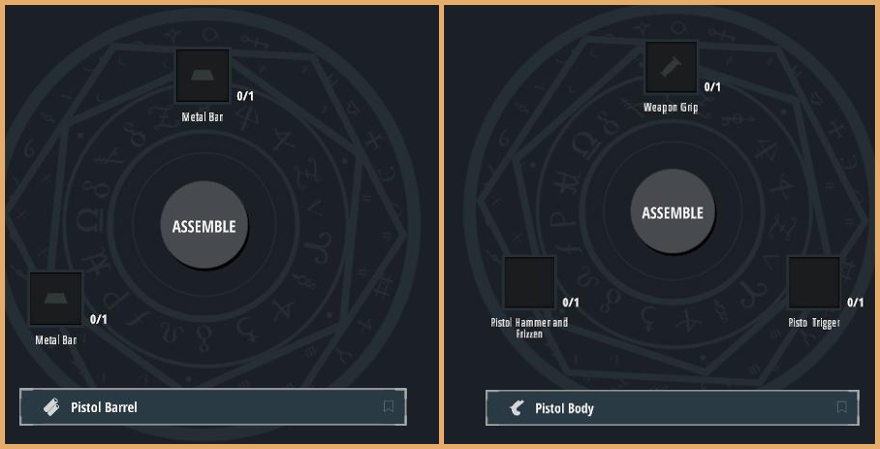
The barrel is obviously pretty simple: just three metal bars (more on those soon). But the body is more complex, requiring the combination of three more crafted components: a pistol hammer and frizzen, a pistol trigger, and a weapon grip, the recipes for which are shown in the screenshot below.

This is just one example—and a relatively simple one, if you can believe it—of the kind of modularity I’m talking about. The stats of a finished item’s component parts will ultimately contribute toward determining the stats of the final product itself. This modular, component-centric approach to item creation gives crafters substantial control over the attributes of crafted items. But if the stats of a crafted item are determined by the stats of its component parts, you might be wondering how the stats of said components are determined.
Now, fair warning, past this point things get even more complex, and because I didn’t have time during the playtest to do quite as much experimenting and note-taking as I would have liked, my understanding of the finer details of the mechanics at play here is limited. I’ll do my best to extrapolate from what I learned during the playtest and to fill any gaps with information from the official wiki wherever possible, but it’s pre-alpha, so it’s likely that all this information, as with so many things in life, will ultimately be irrelevant.
You may have noticed earlier that the basic materials used in crafting recipes have generic names like “metal bar” and “plank” rather than, say, “copper bar” and “cedar plank.” This is also the case for the recipes for refining raw resources into usable materials, as seen in the following screenshot of the recipe for metal bars.
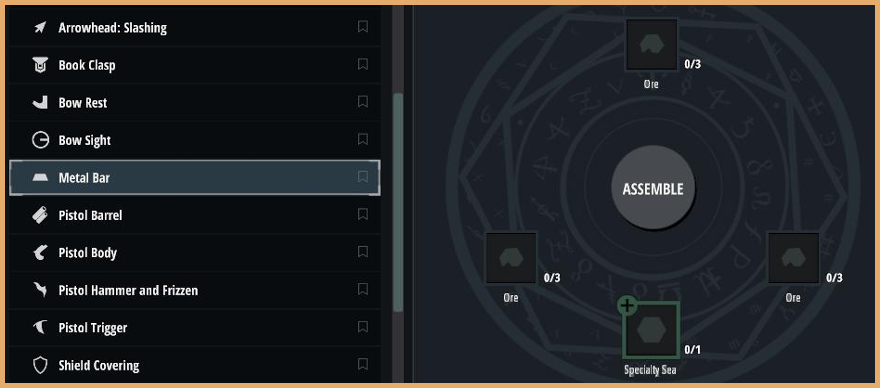
So to smelt a bar of metal, you need three separate stacks of three pieces of ore each—ignore the “specialty seal” slot for now, we’ll come back to that later. As you’ve probably already guessed, each ore slot in the metal bar recipe can be filled with any ore, though each individual stack must consist of three pieces of ore of the same type (copper, iron, etc.) and rarity—white-rarity iron ore won’t stack with green- or blue-rarity iron ore, for instance. However, it isn’t required that all three stacks of ore be identical to one another.
In fact, the system encourages players to mix and match. See, the type(s) of ore you use when crafting a metal bar will determine the finished bar’s stats, which in turn will contribute to the stats of any item that bar is used to create. Mixing (or not mixing) different types of ore will produce varying kinds of metal bars, each with its own specific stats.
 For example, if you craft a metal bar with three stacks of copper, you’ll unsurprisingly end up with a copper bar, which grants increased critical hit chance. But if you use two stacks of tin and one stack of copper, you end up with a bronze bar imbued with a bonus to in-combat stamina regeneration. I wasn’t lucky enough with my harvesting drops to be able to determine the exact effects of using higher-rarity resources, but I’d hazard a guess that it increases the magnitude stat bonus provided by the finished item.
For example, if you craft a metal bar with three stacks of copper, you’ll unsurprisingly end up with a copper bar, which grants increased critical hit chance. But if you use two stacks of tin and one stack of copper, you end up with a bronze bar imbued with a bonus to in-combat stamina regeneration. I wasn’t lucky enough with my harvesting drops to be able to determine the exact effects of using higher-rarity resources, but I’d hazard a guess that it increases the magnitude stat bonus provided by the finished item.
Now, consider this: There are (to my knowledge) five different types of metal ore—six including slag, which I don’t think can be combined to create alloys like the others can. When crafting a metal bar—the most basic component for most metal-based items—players can use up to three different types.
I’m not great with numbers, but I reckon that’s a substantial number of unique combinations, each of which presumably creates a different type of metal bar with its own unique (or at least semi-unique) stats. Now consider that all those types of bars can be combined in however-many ways to create components, such as the pistol barrel we looked at earlier, which can in turn be combined in various ways all the way up the chain until the final product is complete.
Obviously, the other resource types won’t have quite so many possible combinations—you can’t make wood alloys, after all—but even so, the amount of control that crafters have to fine-tune the stats on the items they create is pretty impressive. And that’s still not even quite the end of it.
Yes, there are a couple more (mercifully small and easily explained) facets to Crowfall’s crafting system that allow crafters to customize their creations even further still. First, remember that “specialty seal” slot in the metal bar recipe that I told you to ignore earlier? Specialty seals are optional components that convert an item’s combat stat (e.g. the crit chance bonus on copper bars) into a non-combat stat, such as harvesting or crafting—the specific stat a specialty seal provides is determined by the materials used to craft the seal, natch. There are also similar optional components that can be added to armor recipes to grant various stat bonuses, but I didn’t have much of a chance to fiddle with them myself.
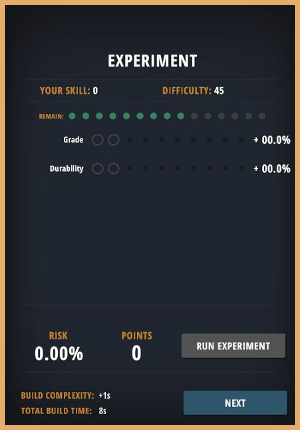 And lastly, there’s experimentation. Before you finish crafting an item, you are given the opportunity to experiment on the item, as seen in the screenshot to the left. You’re given a certain number of experimentation points, represented by the line of green pips near the top, which you can spend to experiment to attempt to raise one or more of the item’s stats (grade and durability in the screenshot). The number of experimentation points available, the number of points that can be invested in a given stat, and the chance of success are all determined by a character’s skill-point investment in the relevant nodes on the skill tree. It’s a gamble, however, as an experiment’s success is not guaranteed—in fact, a critical failure may instead lower the item’s stats. And whether it works or not, it will increase the item’s build time, which isn’t much of an issue for lower-tier crafts, for which the increase is usually only a second or two, but may prove crippling when trying to construct larger and more complex items like siege weapons.
And lastly, there’s experimentation. Before you finish crafting an item, you are given the opportunity to experiment on the item, as seen in the screenshot to the left. You’re given a certain number of experimentation points, represented by the line of green pips near the top, which you can spend to experiment to attempt to raise one or more of the item’s stats (grade and durability in the screenshot). The number of experimentation points available, the number of points that can be invested in a given stat, and the chance of success are all determined by a character’s skill-point investment in the relevant nodes on the skill tree. It’s a gamble, however, as an experiment’s success is not guaranteed—in fact, a critical failure may instead lower the item’s stats. And whether it works or not, it will increase the item’s build time, which isn’t much of an issue for lower-tier crafts, for which the increase is usually only a second or two, but may prove crippling when trying to construct larger and more complex items like siege weapons.
I’m sure there are more details about Crowfall’s crafting systems that I’ve forgotten and still more that I flat-out haven’t discovered yet, but at this point I feel like I’ve written enough to provide what I hope is a decent impression of the overall scheme of things, and I’d wager that by now you’ve read about it as much as you’re willing to read in a single sitting. And of course, there’s still much more to the game that is yet to be explored—classes, skills, and of course the carnage and mayhem of PvP combat, for starters. But for now, I hope you’ve enjoyed this deep-dive into one of the game’s most complex (and intriguing) systems. Until next time, friends.













